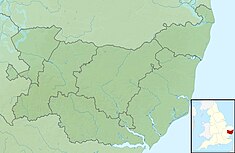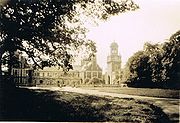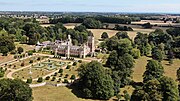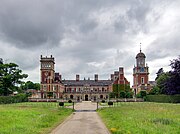Somerleyton Hall
| Somerleyton Hall | |
|---|---|
 The garden front | |
| Type | Country house |
| Location | Somerleyton, Suffolk |
| Coordinates | 52°31′15″N 1°40′23″E / 52.5207°N 1.6731°E |
| Built | 1844 |
| Architect | John Thomas |
| Architectural style(s) | Jacobethan |
| Owner | Sir Samuel Morton Peto |
Listed Building – Grade II* | |
| Official name | Somerleyton Hall |
| Designated | 29 January 1987 |
| Reference no. | 1198046 |
Listed Building – Grade II* | |
| Official name | Stable Court to Somerleyton Hall |
| Designated | 29 January 1987 |
| Reference no. | 1352646 |
Listed Building – Grade II* | |
| Official name | Kitchen Garden of Somerleyton Hall |
| Designated | 29 January 1987 |
| Reference no. | 1031936 |
Listed Building – Grade II | |
| Official name | Remains of Winter Garden of Somerleyton Hall |
| Designated | 29 January 1987 |
| Reference no. | 1031930 |
| Official name | Somerleyton Park |
| Designated | 29 January 1987 |
| Reference no. | 1000188 |
Somerleyton Hall is a country house and 5,000-acre (2,000 ha) estate near Somerleyton and Lowestoft in Suffolk, England owned and lived in by Hugh Crossley, 4th Baron Somerleyton, originally designed by John Thomas. The hall is Grade II* listed on the National Heritage List for England, and its landscaped park and formal gardens are also Grade II* listed on the Register of Historic Parks and Gardens. The formal gardens cover 12 acres (4.9 ha). Inspired by Knepp Wildland, Somerleyton is rewilding 1,000 acres (400 ha) of the estate to which he has introduced free-roaming cattle, large black pigs and Exmoor ponies.
History[edit]
In 1240 a manor house was built on the site of Somerleyton Hall[citation needed] by Sir Peter Fitzosbert, whose daughter married into the Jernegan family. The male line of the Fitzosberts ended, and the Jernegans held the estate until 1604. In 1604 John Wentworth bought the estate. He transformed Somerleyton Hall into a typical East Anglian Tudor-Jacobean mansion. It then passed to the Garney family. The next owner was Admiral Sir Thomas Allin, a native of Lowestoft. He took part in the Battle of Lowestoft (1665) and the Battle of Solebay at Southwold in 1672. Eventually, the male line of that family also died out.
In 1843 Somerleyton Hall and Park were bought by the prosperous entrepreneur and MP Samuel Morton Peto. For the next seven years he carried out extensive rebuilding, creating an Anglo-Italian architecture masterpiece.[1] Paintings were specially commissioned for the house, and the gardens and grounds were completely redesigned. Peto had garden features designed by William Andrews Nesfield and Joseph Paxton. Peto's son, Harold Peto, became a noted garden-designer, but it is not known whether he was influenced by the gardens of Somerleyton.
In 1863 the Somerleyton estate was sold to Sir Francis Crossley of Halifax, West Yorkshire, a carpet manufacturer, who, like Peto, was a philanthropist and a Member of Parliament. Sir Francis' son Savile was created Baron Somerleyton in 1916. The family motto is 'Everything that is good comes from above'.[2] Hugh Crossley, 4th Baron Somerleyton inherited the hall in 2012 where he lives with his family.
The lake at Somerleyton Hall was used by Christopher Cockerell, the inventor of the hovercraft, to carry out his early experiments in 1955.[3]
Description[edit]
Hall[edit]
The hall is a Grade II* listed building. It was designed by John Thomas, an architect who had previously worked for Prince Albert, and was completed in 1850. The clock tower houses a clock designed by Benjamin Vulliamy. It is on the National Heritage List for England.[4]
Formal gardens[edit]
Landscaped park and formal gardens are also Grade II* listed on the Register of Historic Parks and Gardens.[5] The formal gardens cover 12 acres (4.9 ha) and form part of the 5,000-acre (2,000 ha) estate (7.7 square miles). They feature a yew hedge maze, one of the finest in Britain, created by William Andrews Nesfield in 1846, and a ridge and furrow greenhouse designed by Joseph Paxton, the architect of The Crystal Palace.[6] There is also a walled garden, an aviary, a loggia and a 90-metre (300 ft) long pergola, covered with roses and wisteria. The more informal areas of the garden feature rhododendrons and azaleas and a fine collection of specimen trees. The kitchen garden and the stable court are both listed Grade II*.[7][8] The ridge and furrow glasshouses north of the kitchen garden are listed Grade II.[9] Several garden ornaments and statuary are listed; these include the statue of Atalanta, the group of four urns around the sundial, as well as the sundial, all are listed Grade II.[10][11] In the formal gardens, the four urns in the centre and the four stone troughs are both listed Grade II.[12][13] The remains of the Winter Garden and the boundary walling to the formal gardens are listed Grade II.[14][15] The cistern at the south of the terrace to and the retaining wall to the garden front are listed Grade II.[16][17] The screen wall to entrance front of the hall is Grade II listed.[18] The South Lodge and the gates to Somerleyton Hall are listed Grade II.[19]
Estate[edit]
Inspired by the success of Knepp Wildland, a pioneering rewilding project started by Sir Charles Burrell, 10th Baronet in West Sussex, Somerleyton has fenced and is rewilding 1,000 acres (400 ha) of the 5,000-acre (2,000 ha) estate (7.7 square miles), has introduced large black pigs, Exmoor ponies and 100 free-roaming cattle.[20] The plan is to extend the scheme to 1,000 acres (400 ha) (20% of the estate), including the 150 acres (61 ha) Fritton Lake and 600 acres (240 ha) Suffolk Sandlings.[21] Somerleyton is a founding trustee of WildEast, a charitable foundation that promotes regenerative farming and rewilding in the East Anglia.[20]
In popular culture[edit]
- In 1998 Lord and Lady Somerleyton commissioned the English artist Jonathan Myles-Lea, a specialist in country houses, gardens and estates, to paint Somerleyton Hall.[22]
- The house and the maze, where the narrator becomes lost, feature prominently in W. G. Sebald's 1995 novel-memoir The Rings of Saturn.[23]
- The house and grounds were used to stand in for Sandringham House in Stephen Poliakoff's 2003 television drama The Lost Prince,[24]
- The house in Peter Morgan's 2020 series The Crown.[25][26]
- The house and its grounds featured as the principal location in "Neck", the sixth episode in the first series of Tales of the Unexpected (1979).[27]
- The house and gardens were used in the Norfolk episode of the 1989 gameshow Interceptor.
- The 1993 gameshow Time Busters episode The Strange Legacy of Somerweston Hall.
Gallery[edit]
-
Somerleyton Hall in 1880. The Winter Garden (conservatory) on the left was demolished in 1914
-
Somerleyton Hall in 1930
-
aerial view
-
The entrance to the hall
-
The Orangery
-
The maze garden map
-
Topiary archways
References[edit]
- ^ "Somerleyton Hall". BBC Suffolk. Retrieved 20 January 2013.
- ^ "Lady Somerleyton appeals to Morrisons to find her lost family ..." The Telegraph. 18 October 2017.
- ^ "John French: Lowestoft engineer led efforts to mark Somerleyton's links with hovercraft invention". East Anglian Daily Times. 30 November 2012.
Jack George French, always known as John, had written about 80pc of an exhaustive biography about Sir Christopher, who actually carried out the first trials of the hovercraft on the lawns of Somerleyton Hall in 1955.
- ^ Historic England, "Somerleyton Hall (1198046)", National Heritage List for England, retrieved 19 October 2017
- ^ Historic England, "Somerleyton Park (1000188)", National Heritage List for England, retrieved 19 October 2017
- ^ "Gardens & maze" at somerleyton.co.uk Archived 28 March 2012 at the Wayback Machine
- ^ Historic England, "Kitchen garden of Somerleyton Hall (1031936)", National Heritage List for England, retrieved 20 October 2017
- ^ Historic England, "Stable Court to Somerleyton Hall (1352646)", National Heritage List for England, retrieved 20 October 2017
- ^ Historic England, "Ridge and furrow glasshouses 15 meters to north of kitchen garden of Somerleyton Hall (1198195)", National Heritage List for England, retrieved 20 October 2017
- ^ Historic England, "Group of 4 urns around sundial in formal gardens of Somerleyton Hall (1352663)", National Heritage List for England, retrieved 20 October 2017
- ^ Historic England, "Sundial in formal gardens of Somerleyton Hall (1031933)", National Heritage List for England, retrieved 20 October 2017
- ^ Historic England, "Group of 4 urns in centre of formal gardens of Somerleyton Hall (1031934)", National Heritage List for England, retrieved 20 October 2017
- ^ Historic England, "Group of 4 stone troughs in formal gardens of Somerleyton Hall (1352633)", National Heritage List for England, retrieved 20 October 2017
- ^ Historic England, "Remains of Winter Garden of Somerleyton Hall (1031930)", National Heritage List for England, retrieved 20 October 2017
- ^ Historic England, "Boundary walling to formal gardens of Somerleyton Hall (1352662)", National Heritage List for England, retrieved 20 October 2017
- ^ Historic England, "Cistern at South End of terrace to garden front of Somerleyton Hall (1031935)", National Heritage List for England, retrieved 20 October 2017
- ^ Historic England, "Retaining wall of terrace to garden front of Somerleyton Hall (1031931)", National Heritage List for England, retrieved 20 October 2017
- ^ Historic England, "Screen Wall to entrance front of Somerleyton Hall (1198069)", National Heritage List for England, retrieved 20 October 2017
- ^ Historic England, "South Lodge and gates of Somerleyton (1031953)", National Heritage List for England, retrieved 20 October 2017
- ^ a b "Farmers hatch plan to return area the size of Dorset to wild nature". The Guardian. 14 July 2020.
- ^ "Our commitment to the environment". Somerleyton. Retrieved 5 January 2021.
- ^ "Somerleyton Hall". Myles-Lea.com. Retrieved 9 October 2021.
- ^ Rachel B. Doyle (22 April 2011). "Footsteps: Rambling With W. G. Sebald in East Anglia". The New York Times.
- ^ "Suffolk stately home has starring role". East Anglian Daily Times. 24 February 2010 [18 January 2003].
- ^ "The Crown: Somerleyton Hall is transformed into Sandringham". BBC News. 26 November 2020.
- ^ Francesca Syz (15 November 2020). "Travel: The cast of The Crown spent Christmas here - and you should too". The Telegraph.
- ^ Derek James (9 October 2020) [25 January 2019]. "Unexpected victory: When Anglia's Tales toppled BBC's footie favourite". Eastern Daily Press.








